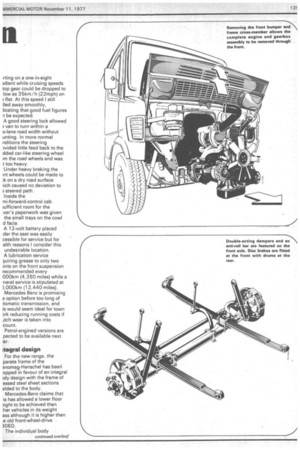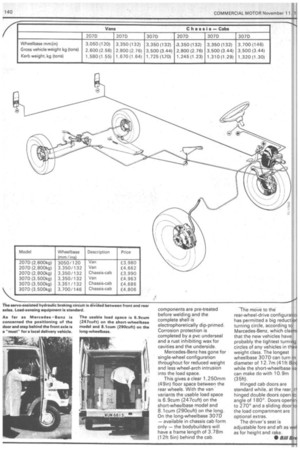The Bremen driv
Page 140

Page 141

Page 142

If you've noticed an error in this article please click here to report it so we can fix it.
VHEN I drove four models in the new Bremen range of vans rom Mercedes-Benz in the Black Forest last month, I was npressed by their quiet ride. In particular, there was no ody boom.
The models I drove, vailable on the Continent since lay, were the 207D, 307D 08 and 308 in one or other of me four basic body variants. he British launch, of course, oes put Mercedes-Benz in the nder-30 cwt unladen weight market for the first time. (See age 57.) In Britain petrol-engined ersions will not initially be vailable. The models on the market will have the same ,400cc (1 46cu in) diesel ngine, clutch and manual earchange and similar Dmponents originally used in me diesel car range. Slight daptations will be made to suit van application.
Even in confined spaces 'here the door opening was :stricted, as long as the driver an squeeze past he can easily et in the driving seat. It's djustable fore and aft,also )1back rake, and placed well Nay from the passenger seat ,hich, in the pick-up version, as no adjustment to the back mst. For me the driver's seat as too erect, but I was assured iis has been rectified for rod uction models.
On the crew bus and panel 3n5 the gap between the seats Dmbines with a high head-line 'id low — 0.61m (2.2ft) — Iatform height to allow easy 1:cess to the rear impartment.
Turning the ignition key then 3ing the pull start resulted in most immediate combustion ithout the need to use the )ld start pre-heat device. But le engine was found to be ling at a high tick-over speed hich was soon corrected by ijustment to the 3sh-mounted throttle control. The gear lever, which has 3en put further to the ght-hand side for Britain, fell nicely to hand without any need to stretch to engage the gears.
All the demonstration vehicles were either empty or at the best only part laden, so performance figures over a . strange route would seem a bit meaningless.
Mercedes-Benz, however, would expect fuel consumption figures of about 12.3-10.4 lit/100km (23-27mpg) in stop/start urban delivery work. On the fast two-laned section I quickly reached a speed above 105km/ h (65mph) for a short spell and I had still more in hand.
Use of the engine in lower gears assisted the hydraulically operated brakes during the descents of the steeper gradients so that no hint of was experienced.
The gear ratios appeare provide an adequate sprea and presented no problems Irting on a one-in-eight ?dient while cruising speeds top gear could be dropped to low as 35km/h (22mph) on ? flat. At this speed I still lied away smoothly, iicating that good fuel figures I be expected.
A good steering lock allowed ? van to turn within a a-lane road width without unting. In more normal nditions the steering pvided little feed back to the dded car-like steering wheel im the road wheels and was t too heavy.
Under heavy braking the int wheels could be made to :k on a dry road surface lich caused no deviation to .1 steered path.
inside the mi-forward-control cab ;ufficient room for the ver's paperwork was given the small trays on the cowl d facia.
A 1 2-volt battery placed 'der the seat was easily cessible for service but for alth reasons I consider this undesirable location.
A lubrication service luiring grease to only two iints on the front suspension recommended every 000km (4,350 miles) while a neral service is stipulated at ),000km (12,440 miles). Mercedes Benz is promising option before too long of lomatic transmission, and is would seem ideal for town )rk reducing running costs if itch wear is taken into count.
Petrol-engined versions are pected to be available next
rtegral design
For the new range, the pa rate frame of the )nomag-Henschel has been opped in favour of an integral )dy design with the frame of essed steel sheet sections aided to the body. Mercedes-Benz claims that is has allowed a lower floor ,ight to be achieved than her vehicles in its weight ass although it is higher than le old front-wheel-drive 306D.
The individual body components are pre-treated before welding and the complete shell is electrophoretically dip-primed. Corrosion protection is completed by a pvc undersea' and a rust inhibiting wax for cavities and the underside.
Mercedes-Benz has gone for single-wheel configuration throughout for reduced weight and less wheel-arch intrusion into the load space.
This gives a clear 1,250mm (49in) floor space between the rear wheels. With the van variants the usable load space is 6.9cum (247cuft) on the short-wheelbase model and 8.1cum (290cuft) on the long. On the long-wheelbase 3070 — available in chassis cab form only — the bodybuilders will have a frame length of 3.78m (12ft 5in) behind the cab. The move to the rear-wheel-drive configura 0 has permitted a big reduct,01 turning circle, according to I Mercedes-Benz, which claim that that the new vehicles have I probably the tightest turnit* circles of any vehicles in tneiii weight class. The longest wheelbase 307D can turn n diameter of 12.7m (41ft 8 q while the short-wheelbase 44 can make do with 10.9m (3 5ft), Hinged cab doors are standard while, at the rear,
t hinged double doors open dI angle of 180°. Doors openn to 2700 and a sliding door,tcc' the load compartment are 1 I
optional extras.
The driver's seat is adjustable fore and aft as as for height and rake.
• Bill al
















































































































































































































































